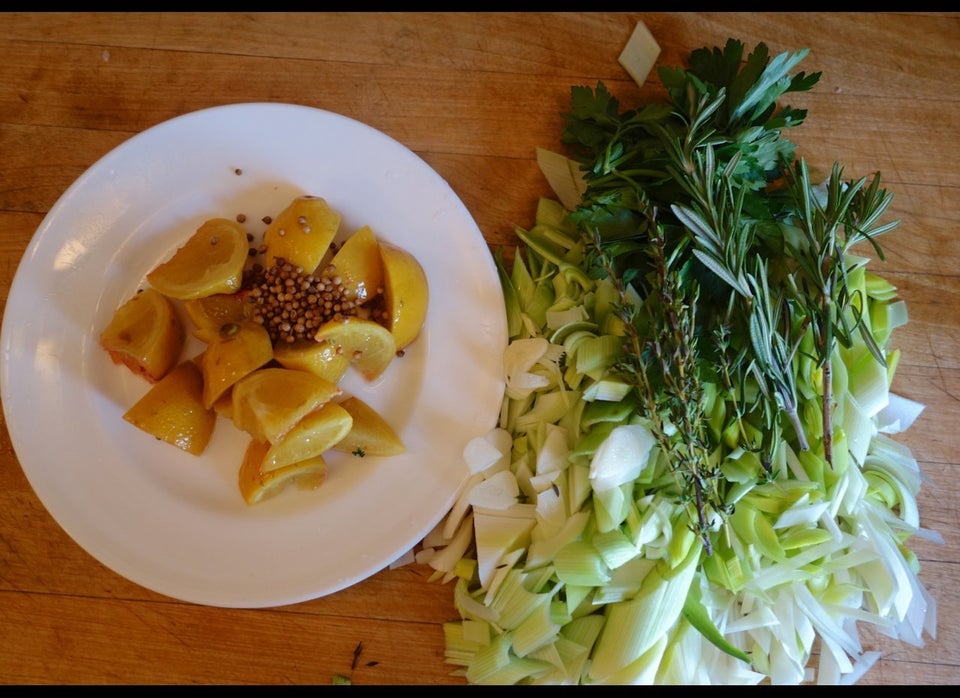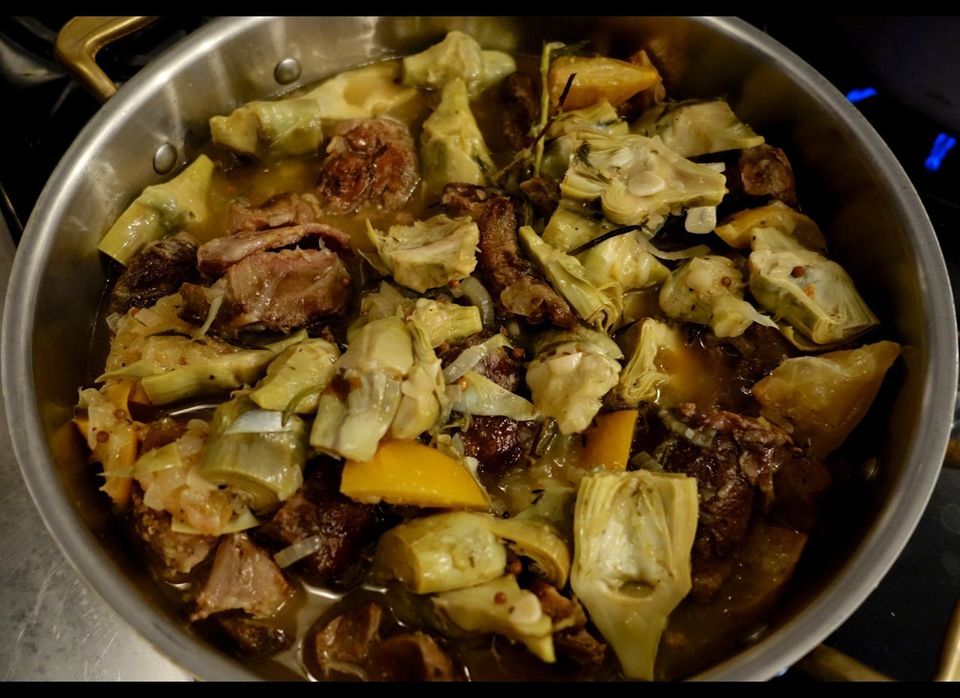One of the axioms for a lower-stress dinner party is "Cook in advance." I don't always do that, but I think I'm calmer when I do. Often, cooking ahead means some sort of braise or, to use a word that is neglected nowadays, stew. Stews - especially those containing meat - are thought of as wintry, even in the Age of Air Conditioning, and there's no avoiding the somewhat Pavlovian association of those deep, dark, intense sauces with cold-weather eating.
But what about a stew with lighter, brighter flavors that wouldn't make people think about woolen hats and mittens? The freezer contained just enough veal - two small shank slices (osso buco) and half a dozen cheeks - fine in texture and flavor; and a favorite farmers' market vendor had plenty of small artichokes. The artichokes were the hook: I thought of the classic French preparation, artichauts à la grecque, with onion, a little garlic, white wine, herbs, lemon and coriander seeds. The incipient plan was to cook the veal using a similar set of ingredients a day in advance, then make a batch of artichokes the following morning with the aim of combining and reheating the two things for our guests. There would be a twist or two, of course; for instance, there was a jar of Moroccan-style salted lemons from our local pan-Asian/Middle-Eastern shop, and these would supplement the fresh lemon in the artichoke dish and replace it in the veal stew. For the veal, I'd also keep the aromatics minimal: no carrots or celery, just lovely young leeks and a little garlic, plus lots of herbs; no meat stock, just white wine and however much vegetable stock was needed.
One advantage of veal - including this deep-colored "rose" veal raised on the small dairy farm from which we buy milk, as opposed to the pallid, generally bland commodity veal you often see in supermarkets and butcher shops - is that even braising cuts cook pretty quickly. That mightn't always be desirable: in the sort of stew I was trying to avoid, long cooking yields rich sauce, just the ticket for an Arctic expedition.
(Note: "In advance" doesn't always mean simple and quick. Apart from trimming the artichokes, this dish presents no technical challenges, but it does have two distinct elements and takes quite a bit of time.)
A day ahead, I heated the oven to about 325 degrees F (say, 165 C). Using olive oil in a shallow 12-inch (30-cm) braising pan into which the meat would fit in one layer, I lightly browned the veal, seasoned with salt and pepper, in olive oil, then removed it and used the same fat to wilt two medium leeks, sliced and rinsed; a big clove of garlic, sliced; plenty of herbs (parsley, rosemary and thyme); and salt and pepper. I stirred regularly, gently scraping the bottom of the pan to loosen any caramelized meat juices. When the leeks had softened but not browned, I returned the meat to the pan and added a couple of tablespoons of whole coriander seeds and four or five Moroccan-style preserved lemon halves, each cut into four (I don't always keep these in the house and never make them myself, and I could have used three small fresh lemons in their stead). Over medium-high heat, I added around a cup and a half (350 ml) of white wine, then a scant cup of light vegetable stock (water or more wine would have been okay). The meat should be at most half-way submerged. I covered the pan tightly, using a double layer of aluminum foil and the lid, and put it in the oven. I checked after an hour; the meat was nearly there, and it took only another 20 minutes to reach spoon-eatable tenderness.
When the meat had cooled a bit - say a quarter of an hour - I removed it from the pan, trimmed any superfluous fat and connective tissue, cut larger pieces in half, then put it to chill overnight. I strained the cooking juices and vegetables through a fine sieve, pressing with a spoon to extract as much liquid as possible, including from the lemons; this yielded nearly two cups (say, 450 ml) of sauce. When it had gelled in the refrigerator (thanks to the collagen in the veal) I scraped off and discarded the layer of fat that had risen to the surface.
The next morning, after a trip to the market (though I could have done it while the meat was cooking the day before), I trimmed and cooked a dozen small artichokes (or was it 14?): pulled off the tough leaves; peeled the stem and exterior of the heart; cut off the top of the remaining leaves and halved the artichoke lengthwise; scraped out any hairy "beard" growing from the heart (most did not have any, they were so young); all the while preventing them from turning brown by keeping them in a bath of cold water with a lemon squeezed into it. In plentiful olive oil, I sweated a young onion and a clove of garlic, sliced; added the juice of one fresh lemon; more of the preserved lemons, each half again cut into four; coriander seeds; thyme; parsley; white wine; and water; slowly simmered this, seasoned with salt and pepper, until the raw wine flavor had diminished, about a quarter of an hour; added the artichoke halves (which were not completely covered by liquid); and simmered/steamed, covered, until these were tender, maybe 10 minutes - but start checking after seven and allow for the possibility that it will take 15. The artichokes should be eatably tender but not too soft, as they will be cooked a little more later. You can find video instructions for dealing with small artichokes on line.
Now, I had two lemony, coriander-y dishes, one of meat and one of vegetables, either of which could have stood on its own (the artichokes by themselves would best be eaten at room temperature, not hot). At that point this was still an idea, so I checked its validity by combining a spoonful of each sauce and tasting. Delicious and harmonious; I don't know what I'd have done if the combination had tasted foul - probably served the artichokes as a first course and made more potatoes to stretch out the veal. When guests were about to arrive, I chose a smaller braising pan that would look nice on the table when second helpings were offered. In it, I heated the veal in its sauce; when it was thoroughly hot, I added the artichokes and their sauce, including the pieces of preserved lemon, and heated them through. After a check for seasoning, I served the dish with boiled new-season potatoes, making sure that each plate included at least one piece of preserved lemon - especially after cooking with the artichokes, these are tender and delicious, including the rinds.
The whole affair, in fact, was tender and delicious. And summery, evoking flavors of Greece for one guest (which validated the "à la grecque" tag for the artichoke preparation). That Mediterranean link could have been strengthened by replacing the veal with lamb shoulder or neck, which might have required longer cooking but no other changes.






